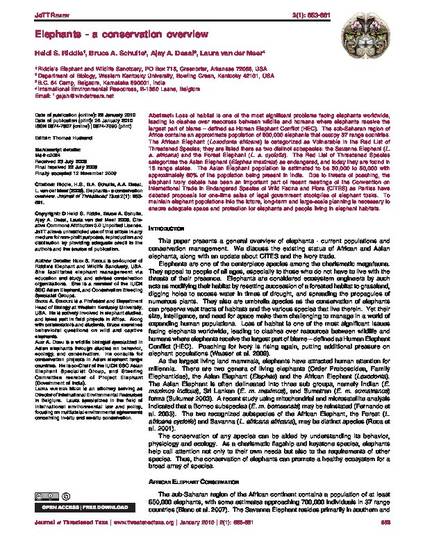
Article
Elephants - A Conservation Overview
Journal of Threatened Taxa
(2010)
Abstract
Loss of habitat is one of the most significant problems facing elephants worldwide,
leading to clashes over resources between wildlife and humans where elephants receive the
largest part of blame – defined as Human Elephant Conflict (HEC). The sub-Saharan region of
Africa contains an approximate population of 500,000 elephants that occupy 37 range countries.
The African Elephant (Loxodonta africana) is categorized as Vulnerable in the Red List of
Threatened Species; they are listed there as two distinct subspecies: the Savanna Elephant (L.
a. africana) and the Forest Elephant (L. a. cyclotis). The Red List of Threatened Species
categorizes the Asian Elephant (Elephas maximus) as endangered, and today they are found in
13 range states. The Asian Elephant population is estimated to be 30,000 to 50,000 with
approximately 60% of the population being present in India. Due to threats of poaching, the
elephant ivory debate has been an important part of recent meetings of the Convention on
International Trade in Endangered Species of Wild Fauna and Flora (CITES) as Parties have
debated proposals for one-time sales of legal government stockpiles of elephant tusks. To
maintain elephant populations into the future, long-term and large-scale planning is necessary to
ensure adequate space and protection for elephants and people living in elephant habitats.
Disciplines
Publication Date
January 26, 2010
DOI
http://dx.doi.org/10.11609/JoTT.o2024.653-61
Publisher Statement
Originally published in the Journal of Threatened Taxa
Citation Information
Riddle, H.S., B.A. Schulte, A.A. Desai, L. van der Meer (2009). Elephants - a conservation
overview. Journal of Threatened Taxa 2(1): 653-661.
Creative Commons license

This work is licensed under a Creative Commons CC_BY International License.
